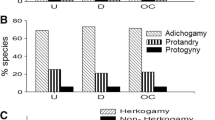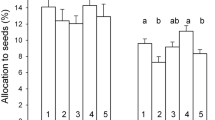Summary
Dry weight allocation to vegetative and reproductive structures in six perennial herbs was studied at three successional sites (quarry, grassland and scrub) on the magnesian limestone in County Durham, England, during the summer of 1978. Two species showed little difference between sites but the other four all displayed the same pattern. Population reproductive effort was highest in the quarry and lowest in the grassland. Reproductive effort of flowering individuals however was the same at all three sites, so that between-site differences in population reproductive effort were entirely a consequence of variation in the proportion of plants which flowered. Indirect evidence suggests that initiation of flowering may be triggered by the attainment of a critical leaf weight. It is suggested that the between-site differences can be explained in terms of the levels of competition at each site and that reproductive effort does not necessarily decline uniformly during succession.
Similar content being viewed by others
References
Abrahamson WG (1975) Reproduction of Rubus hispidus L. in different habitas. Am Midl Nat 93:471–478
Abrahamson WG (1979) Patterns of resource allocation in wildflower populations of fields and woods. Amer J Bot 66:71–79
Abrahamson WG, Gadgil MD (1973) Growth form and reproductive effort in goldenrods (Solidago, Compositae). Am Nat 107:651–661
Bostock SJ (1980) Variation in reproductive allocation in Tussilago farfara. Oikos 34:359–363
Bradbury IK, Hofstra G (1977) Assimilate distribution patterns and carbohydrate concentration changes in organs of Solidago canadensis during an annual developmental cycle. Can J Bot 55:1121–1127
Clapham AR, Tutin TG, Warburg EF (1962) Flora of the British Isles 2nd Edn. Cambridge University Press, London
Gadgil MD, Solbrig OT (1972) The concept of r- and K-selection: Evidence from wild flowers and some theoretical considerations. Am Nat 106:14–31
Gaines MS, Vogt KJ, Hamrick JL, Caldwell J (1974) Reproductive strategies and growth patterns in sunflowers (Helianthus). Am Nat 108:889–894
Gross KL (1981) Predictions of fate from rosette size in four “biennial” plant species: Verbascum thapsus, Oenothera biennis, Daucus carota and Tragopogon dubius. Oecologia (Berl.) 48:209–213
Hawthorn WR, Cavers PB (1978) Resource allocation in young plants of two perennial species of Plantago. Can J Bot 56:2533–2537
Hickman JC (1975) Environmental unpredictability and plastic energy allocation strategies in the annual Polygonum cascadense (Polygonaceae). J Ecol 63:689–701
Hickman JC, Pitelka LF (1975) Dry weight indicates energy allocation in ecological strategy analysis of plants. Oecologia (Berl.) 21:117–121
Lovett Doust J (1980) Experimental manipulation of patterns of resource allocation in the growth cycle of Smyrnium olusatrum L. Biol J Linn Soc 13:155–166
Luftensteiner HW (1980) Der Reproduktionsaufwand in Vier Mitteleuropäischen Pflanzengemeinschaften. Pl Syst Evol 135:235–251
Newell SJ, Tramer EJ (1978) Reproductive strategies in herbaceous plant communities during succession. Ecology 59:228–234
Odum EP (1969) The strategy of ecosystem development. Science 164:262–270
Ogden J (1974) The reproductive strategy of higher plants. II. The reproductive strategy of Tussilago farfara L. J Ecol 62:291–324
Raynall DJ (1979) Population ecology of Hieracium florentinum (Compositae) in a central New York limestone quarry. J Appl Ecol 16:287–298
Roos RH, Quinn JA (1977) Phenology and reproductive allocation in Andropogon scoparius (Gramineae) populations in communities of different successional stages. Amer J Bot 64:535–540
Stewart AJA (1978) Reproductive strategies of six perennial plant species in relation to a successional series. M. Sc. Dissertation, Durham University, England
Sydes C, Grime JP (1981a) Effects of tree leaf litter on herbaceous vegetation in deciduous woodland. I. Field investigations. J Ecol 69:237–248
Sydes C, Grime JP (1981b) Effects of tree leaf litter on herbaceous vegetation in deciduous woodland. II. An experimental investigation. J Ecol 69:249–262
Thompson K, Stewart AJA (1981) The measurement and meaning of reproductive effort in plants. Am Nat 117:205–211
Wilson AM (1980) An investigation into reproductive effort in two successional stages using regression techniques. MSc Dissertation Durham University, England
Author information
Authors and Affiliations
Rights and permissions
About this article
Cite this article
Stewart, A.J.A., Thompson, K. Reproductive strategies of six herbaceous perennial species in relation to a successional sequence. Oecologia 52, 269–272 (1982). https://doi.org/10.1007/BF00363848
Received:
Issue Date:
DOI: https://doi.org/10.1007/BF00363848




